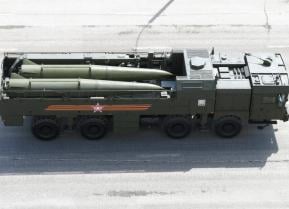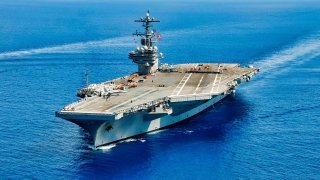The U.S. Navy's Aircraft Carriers Would Be Useless in a China War
The US Navy has long prized the power projection capabilities that its wildly expensive, massive aircraft carriers have allowed for. That might end in disaster.
Summary: The US Navy faces a significant strategic challenge due to the rise of anti-access/area-denial (A2/AD) systems, particularly from countries like China, Russia, Iran, and North Korea. These systems threaten to render US aircraft carriers and their air wings, including advanced F-35B and F-35C warplanes, obsolete by preventing them from getting close enough to enemy territories to be effective. This issue, highlighted nearly a decade ago, points to a broader problem within the Navy and the US military's procurement strategy, which has continued to invest in legacy systems like aircraft carriers and F-35s without adequately addressing the evolving nature of warfare.
Beyond the Aircraft Carrier: Reimagining US Naval Strategy Against A2/AD Threats
The US Navy has long prized the power projection capabilities that its wildly expensive, massive aircraft carriers have allowed for.
Yet, the advent of anti-access/area-denial (A2/AD) systems has led the US Navy to a dangerous place.
Namely, its aircraft carriers, the Navy’s primary weapon at sea, will be rendered useless before even the first shots in any war with an A2/AD-wielding power (such as China, Russia, Iran, or North Korea) were ever fired.
And it isn’t just the aircraft carriers that would be made obsolete overnight by sophisticated A2/AD systems, of the kind that China possesses. It is the air wings of advanced warplanes, such as the F-35B and F-35C variants and other warplanes, that depend on the aircraft carrier to nestle in close to a rival’s territory, allowing for the warplanes to do their jobs.
Should the carriers be kept beyond the range of the warplanes that comprise their carrier air wings, then the entire concept of the aircraft as a warfighting platform is gone.
This is not a new problem.
The Navy Ignores the Aircraft Carrier Crisis at Its Own Peril
Going back to 2015—almost a decade ago—experts have been cautioning about the rising threat that China’s A2/AD systems pose to US aircraft carriers.
Dr. Jerry Hendrix of the Center for New American Security (CNAS) wrote a treatise in 2015 tracing the moment when the US Navy, in his estimation, “suddenly drifted off-course.” In Hendrix’s view, that sudden drift started around the 1990s, shortly after the collapse of the Soviet Union and the bloodless American victory in the Cold War.
According to Hendrix:
"The end of the Cold War—followed by the decision to cancel the replacement aircraft for the A-6 intruder, the A-12 Avenger II—began a precipitous retreat from the range and the deep strike mission that had long characterized the carrier air wing. The rapid successive retirements of the A-6 Intruder, F-14 Tomcat, and the S-3 Viking that followed, and the decision to replace these aircraft with variants of the F/A-18 Hornet—originally designed as a replacement for the short-ranged fighters and light attack aircraft—shrank the average range of the carrier air wing from over 800 [nautical miles] in 1996 to less than 500 nm by 2006. This occurred just when competitor nations, led by China, began to field A2/AD systems with ranges of 1,000 nm or more."
The rot, therefore, has set in deep.
And the war planners in Beijing saw it (as did their autocratic allies). Today, the Americans project a fantasy of dominance upon the world. But all the major weapons systems that the United States can—and will—deploy at the onset of a great power war are tailored for a bygone age.
For decades, American defense contractors and their shameless allies on the Hill (as well as in the Pentagon) have gotten away with bloody murder: overcharging the taxpayer for legacy systems that don’t even come close to meeting America’s strategic needs.
These systems have been developed without taking into account the growing capabilities and intentions of US rivals, such as China. After decades of investing in these technologies, the United States finds itself at a serious disadvantage. For all the money, time, and resources spent building up these systems, they are worthless if they cannot even get within range of their potential targets, thanks to the advent of A2/AD defenses.
Long-Range Warfare is the Future, Not the F-35
Warfare today among great powers will be fought at greater distances than ever before. American offensive systems, though, are all predicated on being able to get close to distant targets. The F-35, like the F/A-18 Hornet will be unable to achieve its mission of striking at enemy targets because of A2/AD.
Rather than blow its finite budget on things like the F-35 and more aircraft carriers, then, the US Navy must lead the way in developing long-range strike weapons that can annihilate A2/AD networks.
Way back in 2015, analysts were urging the Navy (and other branches) to invest in “the areas of unmanned systems, stealth, directed energy, and hypersonics.” Hendrix urged his readers in 2015 to support “experimentation, such as seen with the X-47B [unmanned spaceplane]” in order to burst the A2/AD defensive bubble.
After all, once A2/AD was overcome, the traditional Navy power projection platforms, notably the aircraft carrier, can become relevant again. Rather than take Hendrix's prescient calls more seriously, though, the Navy spent most of its budget on building the Ford-class aircraft carrier.
About the Author
Brandon J. Weichert is a former Congressional staffer and geopolitical analyst who is a contributor at The Washington Times, as well as at American Greatness and the Asia Times. He is the author of Winning Space: How America Remains a Superpower (Republic Book Publishers), Biohacked: China’s Race to Control Life, and The Shadow War: Iran’s Quest for Supremacy. Weichert can be followed via Twitter @WeTheBrandon.


